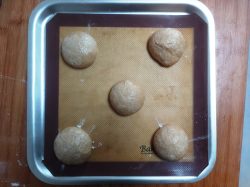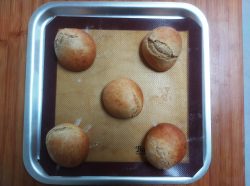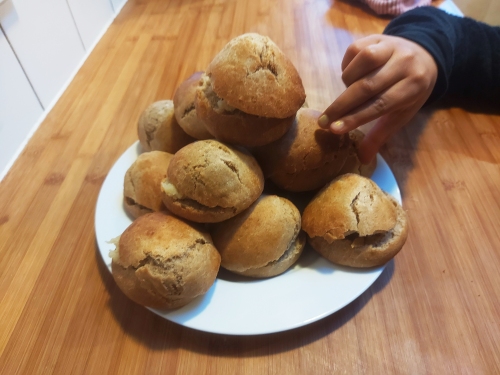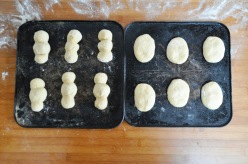
Pangiallo is a cake I encountered in Rome, and indeed one of the last posts I wrote before leaving there in October 2013 mentioned it. But I’ve only recently started to make it, and discovered a quite a lot variation in recipes. Which might seem quite surprising, until you consider it’s a cake that purportedly has roots in Ancient Rome.
Pangiallo, or pancialle, is a Roman, or Lazio, cousin to panforte, “hard bread”, the better-known dense fruit and nut cake of Sienna, and panpepato (“pepper bread”). All three can be arguably be classified as “primitive cakes”. It’s easy to imagine the first cakes were compressed discs of nuts, seeds and dried fruit bound and sweetened with honey. Although food historians suggest pangiallo’s origins are ancient Roman, and panforte is comparatively recent, possibly from the 13th century, people have probably been making these kinds of things for millennia.
Spice trails
There’s debate about what spices the ancient Romans had, but they almost certainly used cardamom, cloves, coriander, black pepper, ginger and nutmeg, and possibly cinnamon too. Such spices, many of which arrived in Europe via the Silk Road, maintained a role as important for feast day foods through the “Dark” and Middle Ages. As they had travelled so far they were expensive, so were used only for special foods on special days.
Britain, of course, has a very similar tradition of rich, spiced fruit cakes for midwinter celebrations in the form of our Christmas cake and Christmas pudding. Their characteristics have similarly ancient origins, though spices were even more scarce and valuable in northern Europe, compared to Italy. Ports such as Genoa and notably Venice were the western extremes of the maritime Silk Route, the dropping-off points for such valuable cargo; spices still had a long way to go before they reached Britain.

Festival of light
Today, Pangiallo is eaten to celebrate the feast day of Santa Lucia, St Lucy, and also for Christmas. Both of these Christian feasts are associated with older winter solstice celebrations. The ancient Romans had Saturnalia, when the ancestor of pangiallo may well have been eaten. When Rome took Christianity as its official religion, many of the pagan festivals were Christianised too, and the consumption of special spiced cakes continued.
The calendar change of 1582 has confused things somewhat as St Lucy’s Day is now celebrated on 13 December in the Gregorian calendar, with Christmas Day closer to the solstice of 21-22 December. In the earlier, Julian calendar, however, St Lucy’s Day would have been closer to the solstice, the day when the night is at its longest. To dispel the darkness, it’s a festival of light, and indeed the very names Lucy and Lucia derive from lux, lucis, the Latin for light.
One Roman blogger suggests the yellow, saffron-tinted glaze of pangiallo is symbolic, looking forward to the new light of spring. The only problem with this theory is that pangiallo doesn’t always feature a yellow glaze. Many versions don’t seem yellow at all, but instead more brown from the dried fruits, caramelised sugar and honey, and even cocoa and chocolate.
Testing times
At the weekend I made the version in Rachel’s book Five Quarter’s: Recipes and Notes from a Kitchen in Rome. It’s closer to the version by the blogger mentioned above and does feature a rich glaze, coloured with saffron and egg yolks. Although they all contain flour, Rachel’s version is not leavened, with yeast or chemicals. So I was intrigued when I read the recipe in Oretta Zanini de Vita’s The Food of Rome and Lazio. Hers features a yeasted bread dough. That said, the dough only forms about 20 per cent of the total mass: which is predominantly raisins. Her original recipe is huge, with “1.8kg (about 4lb) zibibbo (seed raisins)”, with the whole formed into a loaf and proved for 12 hours.
For my testing process, I can’t really do such enormous bakes, so I halved the recipe and tweaked it. Hers included pine nuts too, for example; I love them, but they’re so expensive and the ones in the shops here have all travelled from China, which seems crazy. I’ve also favoured the disc-shaped form. Half quantities still produced four cakes, each scaled with 400g of dough. So I’ve halved it again here.

5g fresh yeast, or 4g active dry yeast
50g plain flour
50g strong white flour
35g caster sugar
100g water, warm
20g olive oil
2g fine sea salt
250g seedless raisins
100g dried figs, quartered
120g whole or blanched almonds
20g candied peel
Spices: a mixture of ground cinnamon, coriander, black pepper, nutmeg, cardamom to total about 8g, to taste
1. Dissolve the sugar in the water.
2. Make a preferment with some of this sugar-water, the yeast and about 25g of the flour.
3. Leave to get bubbly.
4. Put the rest of the flour in a roomy bowl.
5. Add the preferment, the rest of the sugar water, the olive oil and salt.

6. Form a dough, adding more water if necessary, then turn out onto a lightly oiled surface and knead until smooth.
7. Rest 10 minutes, then add the spices, nuts, raisins and peel.
8. Combine. I can’t really say “knead” as it’s all fruit and nuts. It’s more a case of getting your hands in there and squishing it all together.
9. Cover and rest again, for about 6 hours.
10. Form the desire shapes. I recommend a couple of equal balls.
11. Put the balls onto baking sheets lined with parchment or silicone, and squash them down into discs, about 25mm high. If it’s too sticky, flour your hands a bit as you form the discs.
12. Cover and leave again, for about 4-6 hours. Less if it’s warm, more if it’s cold.
13. Heat the oven to 180C .

14. Make a batter with 15g flour, 15g water, 15g oil and 15g sugar. De Vita’s glaze wasn’t coloured yellow, but if you want to, you can add some saffron to the (warm) water and leave it to infuse for half an hour or so. Or cheat and sprinkle in a little turmeric, a spice that’s only mildly flavoured and is more used for colouring.

15. Brush the glaze onto the loaves.
16. Bake for about 30 minutes, until coloured, but without burning too many raisins.

17. Allow to firm up on the trays for 20 minutes or so, then transfer to wire racks to cool completely.

Comparisons
Considering pangiallo is defined by spices, raisins, figs and nuts, the two recipes I tried this week are remarkably different. De Vita sweetens hers only with the fruit and some sugar. Rachel’s uses honey.
I’m struggling a bit at the moment as I keep wondering about vegan stuff for my stall, and honey is a ahem sticking point. Many vegans are staunchly anti-honey. I love the stuff, and beekeeping friends have explained to me it’s a more symbiotic relationship with the bees, not the wholly exploitative one Donald Watson suggested in his 1944 edicts on the founding of the Vegan Society.
Anyway, Rachel’s (on the left in pic above), which uses mixed nuts and more candied peel alongside the honey, has a more pleasing texture. She describes it as like a “soft, chewy, heavily spiced nougat with a whisper of cake”. Which is spot on. De Vita’s, on the other hand, is surprisingly bready, considering the yeasted dough forms such a small proportion of the whole. It’s like a dense, more traditional, fruit cake, even one we’d recognise here in Britain. It’s good, but not as good. So I’m going with honey, more peel, more varied nuts. No yeast. And possibly even egg yolks in the glaze. Though whether it really needs to be quite so yellow is something I’m still undecided about. I need another research trip to Rome!




























































